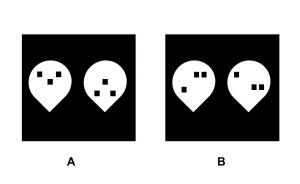4.2 Exposure and Perception
Although a fetus has limited visual experience, after birth, the visual neural pathways develop rapidly to take in infants’ everyday visual environment. Infants begin to learn how to perceive human faces. Studies have shown that infants from an early age prefer top-heavy faces (i.e., there are more shapes at the top of the face, such as two eyes) versus bottom-heavy faces (i.e., there are more shapes at the bottom of the face; see Macchi et al., 2004). Top-heavy faces map onto typical human faces, while bottom-heavy faces do not. This preference for looking at human faces shapes an infant’s ability to recognize faces as well as distinguish between faces. The early experiences that infants have with faces result in perceptual narrowing in facial recognition, which is infants’ ability to discriminate among the types of faces that they frequently experience in their environments. For example, infants and adults are able to discriminate between different human faces, but they are not able to discriminate between different monkey faces due to a lack of experience with those faces.

Similarly, perceptual narrowing occurs with faces based on gender and race. For example, if an infant’s primary caregiver is female, they are likely to prefer female faces over male faces and are better able to distinguish among female faces than among male faces (Quinn et al., 2002). Longitudinal studies have shown that increased exposure to both male and female caregivers helps infants gain more expertise in male faces and reduces perceptual narrowing for that gender (Rennels et al., 2017).
The other-race effect is also observed in infants, with perceptual narrowing occurring for faces within the infant’s own race due to increased exposure to faces within their race (Quinn et al., 2008). Young infants who have not had ample experience with faces are better at distinguishing between other-race faces than older infants who have had more experience with their own race. This bias is attributed to infants’ greater familiarity with same-race faces, which causes them to prefer to look at those faces and thus learn to distinguish between the features of those faces. Studies have shown that exposure to other-race faces reduces preferences and bias toward faces of one’s own race (Spangler et al., 2013).
Video 4.1. “Is It Easier to Recognize People Who Look Like You?” [New Tab] was written and hosted by Mamoudou N’Diaye for Seeker [New Tab].
Media Attributions
- faces © Vivian Hoang is licensed under a Public Domain license
